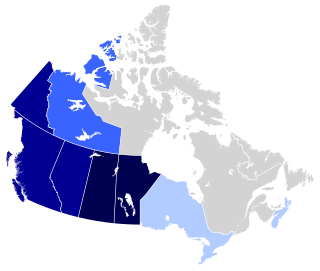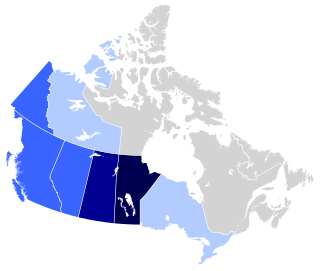
Ukrainian Canadians are Canadian citizens of Ukrainian descent or Ukrainian-born people who immigrated to Canada.
Greek Canadians are Canadian citizens who have full or partial Greek heritage or people who emigrated from Greece and reside in Canada. According to the 2021 Census, there were 262,140 Canadians who claimed Greek ancestry.

Dutch Canadians are Canadians with full or partial Dutch ancestry. According to the Canada 2006 Census, there were 1,035,965 Canadians of Dutch descent, including those of full or partial ancestry. This increased to 1,111,655 or about 4.2% of the entire population of Canada in 2016.
Swedish Canadians are Canadian citizens of Swedish ancestry or Swedes who emigrated to and reside in Canada. The Swedish Canadian community in Canada numbered 349,640 in the 2016 population census. The vast majority of them reside west of Lake Superior, primarily in Winnipeg, Calgary, Edmonton and Vancouver. Toronto is the most popular settlement spot for newcomers. Despite having an influential presence and distinctive cultural bond, only 14,000 Canadian persons of Swedish descent speak Swedish.
Icelandic Canadians are Canadian citizens of Icelandic ancestry, or Iceland-born people who reside in Canada.
Nigerian Canadians are a Canadian ethnic group of Nigerian descent. Nigerians began migrating to Canada during the 1967–1970 Nigerian Civil War. Nigerians were not broken out separately in immigration statistics until 1973. 3,919 landed immigrants of Nigerian nationality arrived in Canada from 1973 to 1991.

Russian Canadians comprise Canadian citizens of Russian heritage or Russians who immigrated to and reside in Canada. According to the 2021 Census, there were 548,140 Canadians who claimed full or partial Russian ancestry. The areas of Canada with the highest percentage population of Russian Canadians are the Prairie Provinces.
The demographics of Toronto, Ontario, Canada make Toronto one of the most multicultural and multiracial cities in the world. In 2021, 57.0 percent of the residents of the metropolitan area belonged to a visible minority group, compared with 51.4 percent in 2016, and 13.6 percent in 1981. Toronto also has established ethnic neighbourhoods such as the multiple Chinatowns, Corso Italia, Little Italy, Little India, Greektown, Koreatown, Little Tokyo, Little Jamaica, Little Portugal, Little Malta, Roncesvalles (Polish), and Bloor West Village (Ukrainian), all of which celebrate the city's multiculturalism. Data from the suburban municipalities are also included for some metrics as most of these municipalities are part of the Toronto CMA.

Leo Rytis Rautins is a Canadian broadcaster, former professional basketball player and the former head coach of the Canadian men's national basketball team. Rautins played in the National Basketball Association (NBA) drafted in the first round of the 1983 NBA draft, by the Philadelphia 76ers. Rautins' NBA career was waylaid by injury. After a brief retirement, Rautins returned to basketball and played in European professional leagues from 1985 until 1992. He has been a broadcaster for the Toronto Raptors since the team's inception in 1995.
Trinidadian and Tobagonian Canadians are Canadians who are fully or partially of Trinidadian and Tobagonian descent or people born in Trinidad and Tobago. There were 105,965 Trinidadian and Tobagonian Canadians in 2021, with the majority of them living in Toronto, Peel Region, and Durham Region.
Latvian Americans are Americans who are of Latvian ancestry. According to the 2008 American Community Survey, there are 93,498 Americans of full or partial Latvian descent.
Norwegian Canadians refer to Canadian citizens who identify themselves as being of full or partial Norwegian ancestry, or people who emigrated from Norway and reside in Canada.
Jamaican Canadians are Canadians of Jamaican descent or Jamaican-born permanent residents of Canada. The population, according to Canada's 2021 Census, is 249,070. The term usually refers to Black Jamaican Canadians. Jamaican Canadians comprise about 30% of the entire Black Canadian population.
Moroccan Canadians are Canadians of full or partial Moroccan descent, as well as people from the state of Morocco who are ethno-linguistic and religious minorities. According to the 2021 Census, there were 98,980 Canadians who claimed full or partial Moroccan ancestry, an increase compared to the 2006 Census. A large minority of Moroccan Canadians are Moroccan Jews.

Macedonian Canadians are Canadian citizens of ethnic Macedonian descent, who reside in Canada. According to the 2021 census there were 39,440 Canadians who claimed full or partial Macedonian ancestry.
European Canadians, or Euro-Canadians, are Canadians who were either born in or can trace their ancestry to the continent of Europe. They form the largest panethnic group within Canada.

Christianity is the most adhered-to religion in Canada, with 19,373,330 Canadians, or 53.3%, identifying themselves as of the 2021 census. The preamble to the Canadian Charter of Rights and Freedoms refers to God. The French colonization beginning in the 17th century established a Roman Catholic francophone population in New France, especially Acadia and Lower Canada. British colonization brought waves of Anglicans and other Protestants to Upper Canada, now Ontario. The Russian Empire spread Orthodox Christianity in a small extent to the tribes in the far north and western coasts, particularly hyperborean nomads like the Inuit. Orthodoxy would arrive in mainland Canada with immigrants from the eastern and southern Austro-Hungarian Empire and western Russian Empire starting in the 1890s; then refugees from the Soviet Union, Eastern Bloc, Greece and elsewhere during the last half of the 20th century.
Albanian Canadians are Canadians of full or partial Albanian ancestry and heritage in Canada. They trace their ancestry to the territories with a large Albanian population in the Balkans among others to Albania, Italy, Kosovo, North Macedonia and Montenegro. They are adherents of different religions and are predominantly Christians, Muslims as well as Irreligious.
Latvian Canadians are Canadians of full or partial Latvian descent. At the 2011 census, there were about 27,355 people of Latvian descent in Canada.
Ethiopian Canadians are a hyphenated ethnicity of Canadians who are of full or partial Ethiopian national origin, heritage and/or ancestry, Canadian citizens of Ethiopian descent, or an Ethiopia-born person who resides in Canada. According to the 2016 Canadian Census, 44,065 people reported Ethiopian ancestry.





